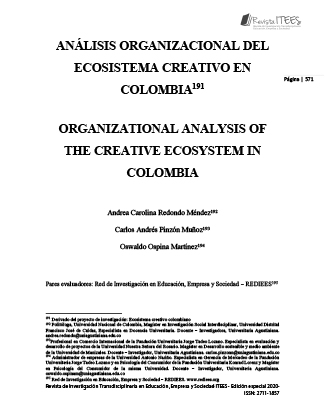XXX. ORGANIZATIONAL ANALYSIS OF THE CREATIVE ECOSYSTEM IN COLOMBIA
##plugins.themes.bootstrap3.article.main##
Abstract
The aim of this research is to analyze the creative ecosystem of Colombia from an
organizational perspective, highlighting culture as a catalyst for new business practices,
which are recognized as successful, but which do not identify or relate directly to the structure
thereof. This is to recognize the elements that are part of the Colombian creative ecosystem
and to identify its functioning based on its contribution to companies in the cultural sector.
We used an analytical method that combined the structural and functional aspects of the
cultural sector in Colombia, using variables that allowed us to identify the composition of
the sector and its relationship with the environment, these being part of the institutionalist,
financing, networking, and technical knowledge. The results obtained reflect the existence of
a strong organizational structure within the country, but with little knowledge and access for
the direct protagonists of the cultural sector, be they artists, entrepreneurs, or entrepreneurs.
It is also a structure that reflects the Colombian creative ecosystem and facilitates the
entrepreneurial activity of the sector, but which does not have sufficient coverage to be fully
recognized and harmonized. It is concluded that it is necessary to realize and relate the
complete structure of the creative ecosystem for Colombia based on skills and knowledge,
customer connection, financing, and professional networking.
Download Statistics
##plugins.themes.bootstrap3.article.details##
creative ecosystem, cultural sector, cultural industries, cultural business
Ministerio de Cultura, Dirección de comunicaciones grupo de gestión y ejecución.
Bernal, C. (2010). Metodología de la Investigación para la administración, economía,
humanidades y ciencias sociales. México, México: Editorial Pearson Educación.
Bravo, M. Dini y M. Rueda, (2020). “La contribución de las asociaciones empresariales al
desarrollo de las políticas productivas: elementos para la elaboración de un marco
analítico”, Documentos de Proyectos (LC/TS.2020/13), Santiago, Comisión
Económica para América Latina y el Caribe (CEPAL).
Cámara de Comercio de Bogotá (2020). Informe de gestión 2019.
Casares, L., Christen, M., Jaramillo, E., Villasenor, L., y Zamudio, L. (1999). Técnicas
actuales de investigación documental. México, México: Editorial Trillas.
Cardozo, Pedro. Chavarro, Andrés. Ramírez, Carlos. (2007). Teorías de internacionalización.
DOI: https://bit.ly/30umApV
Congreso, C. (2017). Presidencia. Retrieved from https://bit.ly/3hhkJeI
Cultura, M. d. (2018). Departamento Administrativo de la Presidencia de la República.
Retrieved from https://bit.ly/3eNMk5I
DANE, (2019). Economía naranja. Segundo reporte 2019. Gobierno de Colombia.
González Vélez, Estefanía. (2013). El ecosistema de las industrias culturales en Colombia.
En: Revista UIS Humanidades. Vol. 41, No. 2. julio - diciembre de 2013, pp. 81-103
González, L. V., & Mesa, M. A. (2018). Universidad Católica. Retrieved from
https://bit.ly/32F2zQ2
Hernández, R., Fernández, C. y Baptista, P. (2014). Metodología de la Investigación.
México, México: Editoria MacGraw Hill Education.
Laboral, O. U. (2018). Observatorio laboral Universidad del Rosario. Retrieved from
https://bit.ly/3hnlByG
Machiado, Javier. (s.f.) Observatorio de Cultura y Economía. https://bit.ly/3fZxivb
Market, B. A. (2013). Cámara de Comercio de Bogotá. Retrieved from https://bit.ly/3jrmSGv
Mincultura. (2018, s.f). Ministerio de Cultura. Retrieved from https://bit.ly/3hfeZSA
Ministerio de Cultura (2019). ABC de la economía naranja.
Redondo, A. C. (2018). Industrias culturales latinoamericanas y su aporte al desarrollo
social. En. J. Hernández Acosta, A. C. Redondo Méndez y O. Ospina Martínez (eds.)
Industrias culturales y economía creativa en Latinoamérica. Desarrollo económico y
social en la región (pp. 23-70). Bogotá: Editorial Uniagustiniana.
República, B. d. (2018). Reporte de la situación de crédito en Colombia. Bogotá: Banco de
la República.
Servais, Alain (2014). «A Resistance Ecosystem». Talking Galleries Notebook. 02. Screen
Projects
Whetten, D., & Cameron, S. (2011). Desarrollo de habilidades directivas (8a ed.). México:
Pearson Educación





